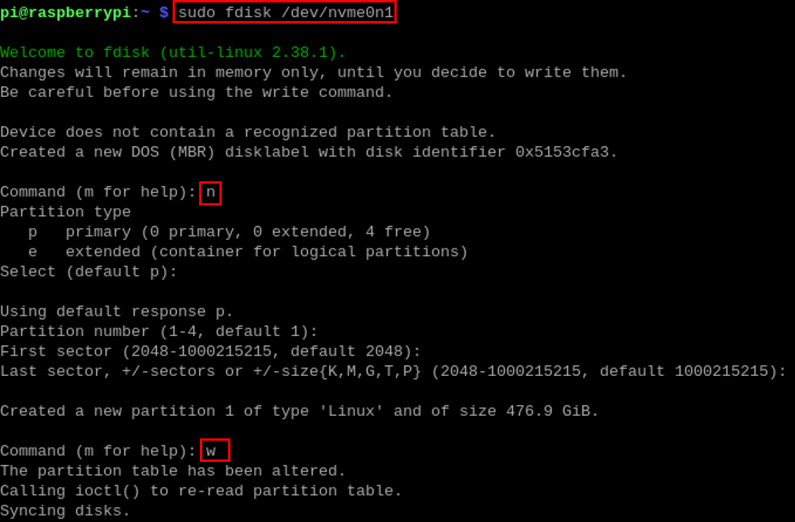Configuring SSD (optional)
If the product model contains an SSD, you need to finish creating partition, formatting and mounting before using SSD.
Creating Partition
Preparation:
The device contains an SSD.
Steps:
- Run the following command to view all disk partitions on the ED-HMI3020-101C.
sudo lsblk -o UUID,NAME,FSTYPE,SIZE,MOUNTPOINT,LABEL,MODEL
After running the command, the information displayed is as follows:
In the figure, the disk whose “NAME” is “nvme0n1” indicates the SSD. As can be seen from the figure below, the SSD is not partitioned.

UUID,NAME,FSTYPE,SIZE,MOUNTPOINT,LABEL and MODEL are disk parameters that need to be listed.
The types of MOUNTPOINT are “/” and “/boot”.
LABEL is the corresponding disk model.
FSTYPE indicates the file system type contained.
- Run the following command to create a partition for the SSD.
sudo fdisk /dev/nvme0n1
Set the partition parameters according to the prompts:

- Run the following command to check whether the partition is created successfully.
lsblk

After executing the command, if the “TYPE” column displays “part”, it means that the partition is successful.
After executing the command, if the “TYPE” column does not display “part”, it means that the partition is failed.
Formatting
The SSD of device by default is not formatted. After the disk partition is completed, it needs to be formatted into ext4 format.
Preparation:
Disk partitioning of SSD has been completed.
Steps:
Execute the following command to format the SSD named nvme0n1p1 into ext4 format.
sudo mkfs.ext4 /dev/nvme0n1p1

Mounting SSD
The SSD of device by default needs to be configured to mount SSD in a specific folder, usually in the “/mnt” folder (such as “/mnt/SSD”).
Preparation:
Partitioning and formatting of the SSD have been completed.
Steps:
- Run the following command to view all disk partitions on the ED-HMI3020-101C.
sudo lsblk -o UUID,NAME,FSTYPE,SIZE,MOUNTPOINT,LABEL,MODEL
After running the command, the information displayed is as follows:
In the figure, the disk whose “NAME” is “nvme0n1p1” indicates the SSD to be mounted.

UUID,NAME,FSTYPE,SIZE,MOUNTPOINT,LABEL and MODEL are disk parameters that need to be listed.
The types of MOUNTPOINT are “/” and “/boot”.
LABEL is the corresponding disk model.
FSTYPE indicates the file system type contained.
- Run the following command to obtain the location of disk partition.
sudo blkid
After executing the command, the following information is displayed, which the SSD partition is displayed as “/dev/nvme0n1p1”.

- Create a target folder as the mount point of SSD. Assuming that the mount name is SSD and the directory to be mounted is “/mnt”, the command to be executed is as follows:
sudo mkdir /mnt/SSD
- Mount the SSD at the created mount point, and execute the following command:
sudo mount /dev/nvme0n1p1 /mnt/SSD
- Run the following command to check whether the SSD is mounted successfully.
lsblk

After executing the command, if the display information lists the mount point “/mnt/SSD”, it means the mount of SSD is successful.
After executing the command, if the displayed information does not list the mount point information, it means that the mount of SSD is failed.
